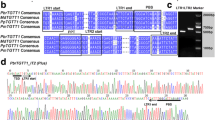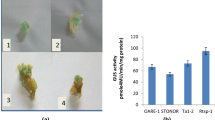Abstract
Ogre elements are a distinct group of plant Ty3/gypsy-like retrotransposons characterized by several specific features, one of which is a separation of the gag-pol region into two non-overlapping open reading frames: ORF2 coding for Gag-Pro, and ORF3 coding for RT/RH-INT proteins. Previous characterization of Ogre elements from several plant species revealed that part of their transcripts lacks the region between ORF2 and ORF3, carrying one uninterrupted ORF instead. In this work, we investigated a hypothesis that this region represents an intron that is spliced out from part of the Ogre transcripts as a means for preferential production of ORF2-encoded proteins over those encoded by the complete ORF2–ORF3 region. The experiments involved analysis of transcription patterns of well-defined Ogre populations in a model plant Medicago truncatula and examination of transcripts carrying dissected pea Ogre intron expressed within a coding sequence of chimeric reporter gene. Both experimental approaches proved that the region between ORF2 and ORF3 is spliced from Ogre transcripts and showed that this process is only partial, probably due to weak splice signals. This is one of very few known cases of spliced LTR retrotransposons and the only one where splicing does not involve parts of the element’s coding sequences, thus resembling intron splicing found in most cellular genes.




Similar content being viewed by others
References
Arkhipova IR, Pyatkov KI, Meselson M, Evgen’ev MB (2003) Retroelements containing introns in diverse invertebrate taxa. Nat Genet 33:123–124
Arumuganathan K, Earle E (1991) Nuclear DNA content of some important plant species. Plant Mol Biol Rep 9:208–218
Atwood A, Lin JH, Levin HL (1996) The retrotransposon Tf1 assembles virus-like particles that contain excess Gag relative to integrase because of a regulated degradation process. Mol Cell Biol 16:338–346
Belancio VP, Hedges DJ, Deininger P (2006) LINE-1 RNA splicing and influences on mammalian gene expression. Nucleic Acids Res 34:1512–1521
Breathnach R, Benoist C, O’Hare K, Gannon F, Chambon P (1978) Ovalbumin gene: evidence for a leader sequence in mRNA and DNA sequences at the exon-intron boundaries. Proc Natl Acad Sci USA 75:4853–4857
Brierley C, Flavell AJ (1990) The retrotransposon copia controls the relative levels of its gene products post-transcriptionally by differential expression from its two major mRNAs. Nucleic Acids Res 18:2947–2951
Buratti E, Baralle FE (2004) Influence of RNA secondary structure on the pre-mRNA splicing process. Mol Cell Biol 24:10505–10514
Burset M, Seledtsov IA, Solovyev VV (2000) Analysis of canonical and non-canonical splice sites in mammalian genomes. Nucleic Acids Res 28:4364–4375
Chytilova E, Macas J, Galbraith DW (1999) Green fluorescent protein targeted to the nucleus, a transgenic phenotype useful for studies in plant biology. Ann Bot 83:645–654
Davies E, Larkins BA, Knight RH (1972) Polyribosomes from peas: an improved method for their isolation in the absence of ribonuclease inhibitors. Plant Physiol 50:581–584
Dellaporta SL, Wood J, Hicks JB (1983) A plant DNA minipreparation: version II. Plant Mol Biol Rep 1:19–21
Forbes EM, Nieduszynska SR, Brunton FK, Gibson J, Glover LA, Stansfield I (2007) Control of gag-pol gene expression in the Candida albicans retrotransposon Tca2. BMC Mol Biol 8:94. doi:10.1186/1471-2199-8-94
Gao X, Havecker ER, Baranov PV, Atkins JF, Voytas DF (2003) Translational recoding signals between gag and pol in diverse LTR retrotransposons. RNA 9:1422–1430
Havecker ER, Gao X, Voytas DF (2004) The diversity of LTR retrotransposons. Genome Biol 5:225. doi:10.1186/gb-2004-5-6-225
Hebsgaard SM, Korning PG, Tolstrup N, Engelbrecht J, Rouze P, Brunak S (1996) Splice site prediction in Arabidopsis thaliana pre-mRNA by combining local and global sequence information. Nucleic Acids Res 24:3439–3452
Houzet L, Morichaud Z, Mougel M (2007a) Fully-spliced HIV–1 RNAs are reverse transcribed with similar efficiencies as the genomic RNA in virions and cells, but more efficiently in AZT-treated cells. Retrovirology 4:30. doi:10.1186/1742-4690-4-30
Houzet L, Paillart JC, Smagulova F, Maurel S, Morichaud Z, Marquet R, Mougel M (2007b) HIV controls the selective packaging of genomic, spliced viral and cellular RNAs into virions through different mechanisms. Nucleic Acids Res 35:2695–2704
Ibrahim AF, Watters JA, Clark GP, Thomas CJ, Brown JW, Simpson CG (2001) Expression of intron-containing GUS constructs is reduced due to activation of a cryptic 5′ splice site. Mol Genet Genomics 265:455–460
Irwin PA, Voytas DF (2001) Expression and processing of proteins encoded by the Saccharomyces retrotransposon Ty5. J Virol 75:1790–1797
Jackson AO, Larkins BA (1976) Influence of ionic strength, pH, and chelation of divalent metals on isolation of polyribosomes from tobacco leaves. Plant Physiol 57:5–10
Jewell NA, Mansky LM (2000) In the beginning: genome recognition, RNA encapsidation and the initiation of complex retrovirus assembly. J Gen Virol 81:1889–1899
Kumar A, Bennetzen JL (1999) Plant retrotransposons. Annu Rev Genet 33:479–532
Liang C, Hu J, Russell RS, Kameoka M, Wainberg MA (2004) Spliced human immunodeficiency virus type 1 RNA is reverse transcribed into cDNA within infected cells. AIDS Res Hum Retroviruses 20:203–211
Luban J, Goff SP (1994) Mutational analysis of cis-acting packaging signals in human immunodeficiency virus type 1 RNA. J Virol 68:3784–3793
Macas J, Neumann P (2007) Ogre elements—a distinct group of plant Ty3/gypsy-like retrotransposons. Gene 390:108–116
Mount SM (1982) A catalogue of splice junction sequences. Nucleic Acids Res 10:459–472
Neumann P, Pozarkova D, Macas J (2003) Highly abundant pea LTR retrotransposon Ogre is constitutively transcribed and partially spliced. Plant Mol Biol 53:399–410
Neumann P, Koblizkova A, Navratilova A, Macas J (2006) Significant expansion of Vicia pannonica genome size mediated by amplification of a single type of giant retroelement. Genetics 173:1047–1056
Neumann P, Yan H, Jiang J (2007) The centromeric retrotransposons of rice are transcribed and differentially processed by RNA interference. Genetics 176:749–761
Rabson AB, Graves BJ (1997) Synthesis and processing of viral RNA. In: Coffin JM, Hughes SH, Varmus HE (eds) Retroviruses. Cold Spring Harbor Laboratory Press, New York, pp 205–262
Staden R (1996) The Staden sequence analysis package. Mol Biotechnol 5(3):233–241
Tamura M, Kajikawa M, Okada N (2007) Functional splice sites in a zebrafish LINE and their influence on zebrafish gene expression. Gene 390:221–231
Thompson JD, Higgins DG, Gibson TJ (1994) CLUSTAL W: improving the sensitivity of progressive multiple sequence alignment through sequence weighting, position-specific gap penalties and weight matrix choice. Nucleic Acids Res 22:4673–4680
Vancanneyt G, Schmidt R, O’Connor-Sanchez A, Willmitzer L, Rocha-Sosa M (1990) Construction of an intron-containing marker gene: splicing of the intron in transgenic plants and its use in monitoring early events in Agrobacterium-mediated plant transformation. Mol Gen Genet 220:245–250
Vicient CM, Kalendar R, Schulman AH (2001) Envelope-class retrovirus-like elements are widespread, transcribed and spliced, and insertionally polymorphic in plants. Genome Res 11:2041–2049
Acknowledgments
We thank Ms. J. Látalová and Ms. H. Štěpančíková for excellent technical assistance. This work was supported by grants IAA500960702 and AVOZ50510513 from the Academy of Sciences of the Czech Republic, and LC06004 from the Ministry of Education, Youth and Sport of the Czech Republic.
Author information
Authors and Affiliations
Corresponding author
Additional information
Communicated by M.-A. Grandbastien.
Electronic supplementary material
Below is the link to the electronic supplementary material.
Rights and permissions
About this article
Cite this article
Steinbauerová, V., Neumann, P. & Macas, J. Experimental evidence for splicing of intron-containing transcripts of plant LTR retrotransposon Ogre . Mol Genet Genomics 280, 427–436 (2008). https://doi.org/10.1007/s00438-008-0376-8
Received:
Accepted:
Published:
Issue Date:
DOI: https://doi.org/10.1007/s00438-008-0376-8




